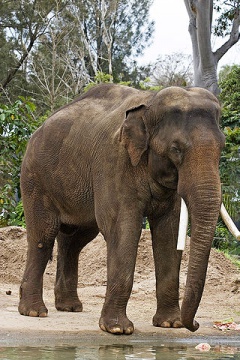Difference between revisions of "Elephant"
m (adding feed amount) |
|||
| Line 35: | Line 35: | ||
}} | }} | ||
| − | The highly intelligent [[elephant]] can be domesticated to serve as | + | The highly intelligent [[elephant]] can be domesticated to serve as transport animals, and are said to be able to respond to a number of commands. While it is said that elephants have excellent memories, it is also said that they can be stubborn, lower their heads and just charge through their obstacle. So while a tamer can use 450 grams of [[hay]] in an attempt to domesticate these huge creatures over a course of five days, there is only around a 30% chance of success. They also require a great deal of feed to maintain, so keeping them as pets could become an expensive endeavor. |
Once an elephant is tamed, it can be saddled with a regular [[saddle]] and can hold up to six passengers, including the driver. | Once an elephant is tamed, it can be saddled with a regular [[saddle]] and can hold up to six passengers, including the driver. | ||
Latest revision as of 13:22, 26 May 2022
| Interwiki |
|---|
|
български • Deutsch • English • Español • Esperanto • Français • Italiano • Lietuvių • Lojban • Nederlands • Polska • Português • Русский • Suomi • Svenska • Türkçe • 中文 |
| |||||||||||||||||||||||||||||||||||||||||||||||||||
The highly intelligent elephant can be domesticated to serve as transport animals, and are said to be able to respond to a number of commands. While it is said that elephants have excellent memories, it is also said that they can be stubborn, lower their heads and just charge through their obstacle. So while a tamer can use 450 grams of hay in an attempt to domesticate these huge creatures over a course of five days, there is only around a 30% chance of success. They also require a great deal of feed to maintain, so keeping them as pets could become an expensive endeavor.
Once an elephant is tamed, it can be saddled with a regular saddle and can hold up to six passengers, including the driver.
Real World Historical Context
see: White Elephant
The expression white elephant derives from a white elephant being considered sacred and therefore disqualified from useful work, yet posing a large ownership cost. The origin of the expression is from the story that the kings of Siam gave white elephants as a gift to courtiers they disliked, in order to ruin the recipient by the great expense incurred in maintaining the animal.
see: Howdah
A howdah is a carriage which is positioned on the back of an elephant, or occasionally some other animal such as a camel, used most often in the past to carry wealthy people during progresses or processions, hunting or in warfare. It was also a symbol of wealth for the owner and as a result might be elaborately decorated, even with expensive gemstones.
Steeds must first be domesticated and adopted in order to be ridden.
